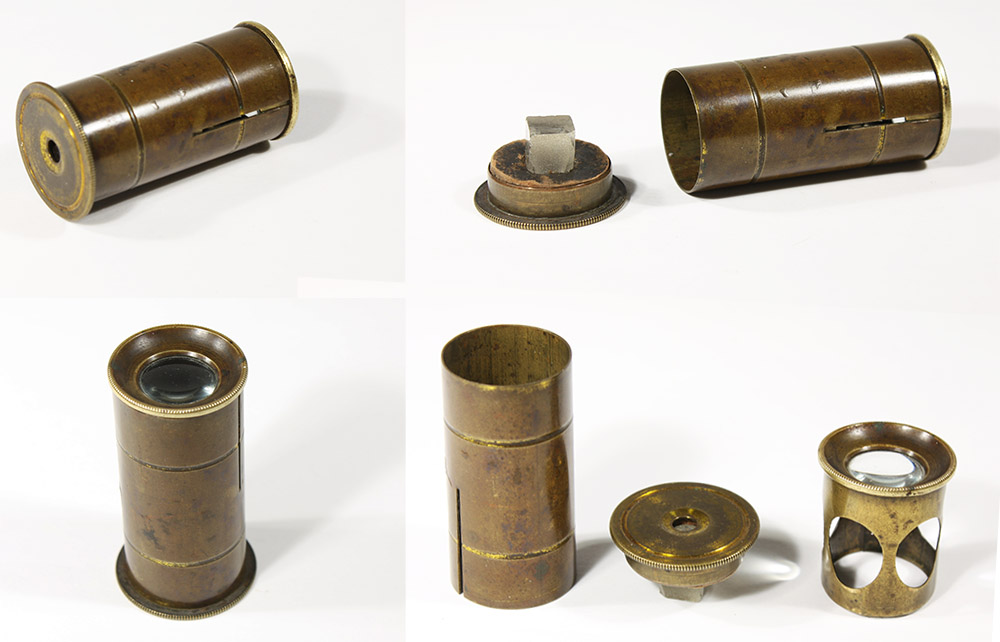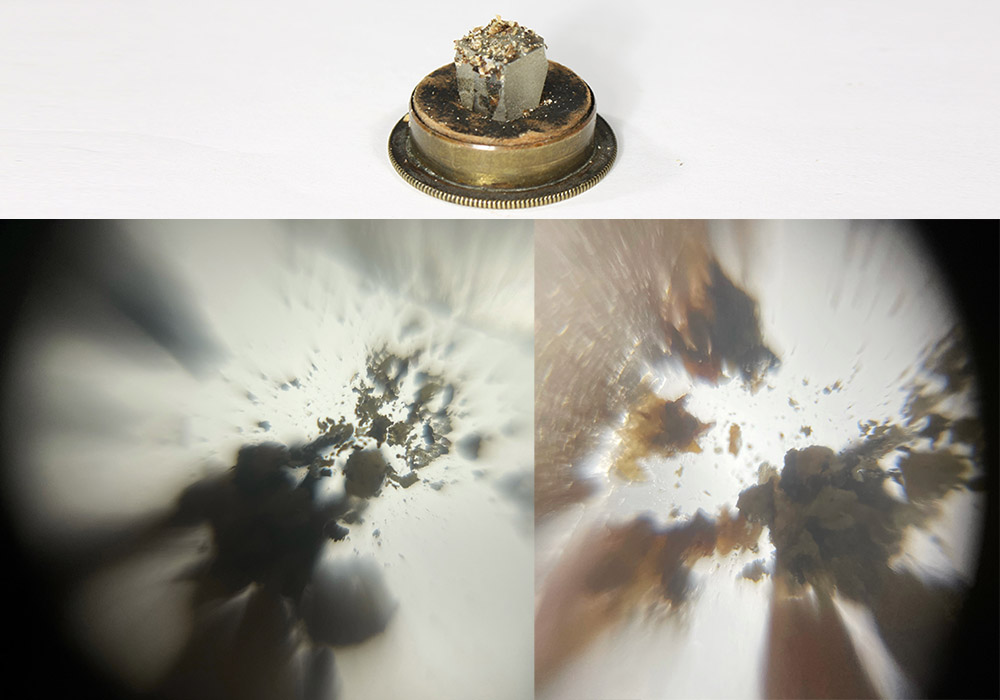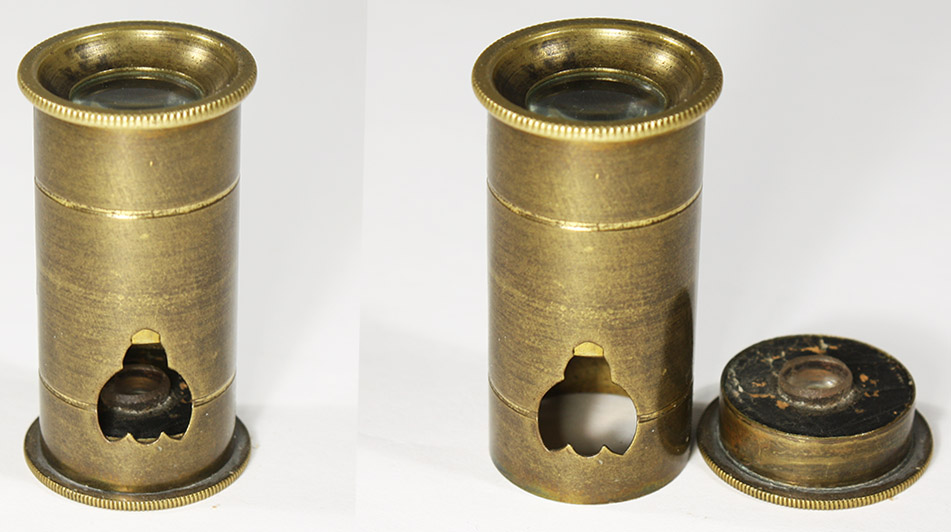
Figure 1. A late 1800s pocket microscope of the type described by Alphonse Chevallier in 1875.
Jean-Baptiste Alphonse Chevallier, 1793-1879
"Microscope portatif" ("pocket microscope"), circa 1875
by Brian Stevenson
last updated May, 2021
Students of antique microscopes are probably familiar with small magnifying apparatus such as that illustrated in Figure 1. They consist of a tube of approximately 2 inches / 5 cm in length and about half that in diameter. A low-power magnifying lens, mounted on an open-sided framework, slides into one end. The use of this component is obvious: one removes it from the tube, places it over an object to be studied, and the framework holds the lens at the correct focal length above the specimen.
The other end of the device is less obvious. It consists of a thick glass that is mounted through a cardboard disc, which in turn is held by a brass disc. The glass piece is convex on the outside, which provides a low power of magnification. The other end of the glass is flat, and often square. The focal point of this simple magnifier is the flat plane of the glass. It is essentially useless for examining objects that are mounted on slides, as the thickness of a coverslip is such that the specimen is out of focus. What, then, is the purpose of this device?

Figure 1.
A late 1800s pocket microscope of the type described by Alphonse Chevallier in 1875.
The answer comes from an 1875 publication by Alphonse Chevallier on "Du poivre: de ses usages, de ses propriétés, des falsifications qu'on lui fait subir, des moyens de les reconnaître" ("Pepper: its uses, its properties, the falsifications that it is subjected to, the means of recognizing them") (Figures 2 and 3). That article referred to this form of magnifier as "microscope portatif de M. Chevallier" ("portable microscope of Mr. Chevallier"), suggesting that he may have been instrumental in its design and construction. Notably, earlier publications from Chevallier on the topic did not describe this type of magnifier, but instead suggested use of a Stanhope lens or other such instrument.
Chevallier's description for using the "microscope portatif":
"Our research on ground peppers has shown that we can recognize pepper mixed with starch through use of the microscope.
To immediately recognize various impurities, we use a portable microscope that is composed of two parts, a cap and a tube. Placed in the center of the cap is a stick of crown glass, one surface of which has a convex curve, which produces the magnification; the other surface is flat and serves as an object holder.
Remove the cap, lightly moisten the flat part of the glass stick, apply the pepper powder, put the cap back in the tube, and examine by refraction, either in broad daylight or by the light of a lamp or a candle.
This little instrument has been exceedingly useful to us in the examination of powdered peppers sold by grocers' merchants in Paris; it allowed us to recognize ground peppers to which have been added starches, gravel, maniguette, powders of olive pits, etc.
Its size allows it to be carried with ease."
Examination of extant "microscopes portatifs de Chevallier" revealed that these devices function very well. Ground pepper, sugar crystals, and other such objects can be seen quite clearly when they are adhered to the flat surface of the glass (Figure 4).

Figure 2.
Illustrations from Chevallier's 1875 (left) and 1878 (right) publications on identifying contaminants of ground pepper.

Figure 3.
An illustration from Chevallier's 1875 paper on pepper: "contaminated pepper – P, pepper; G, gravel; F, starch; M, maniguette (another type of spice).

Figure 4.
Images of ground pepper on the flat surface of a Chevallier magnifier. The narrow diameter and focal length of the lens are well-suited for the human eye, but are a challenge for the camera.

Figure 5.
Presumably a later version of Chevallier's pocket microscope, this instrument has a small cut-out in the tube. That hole is ideal for applying ground pepper or other substance onto the flat end of the lens, using a stick or swab, without disassembling the apparatus.
Jean-Baptiste Alphonse Chevallier was a distinguished pharmacist and public-health researcher who was active through much of the nineteenth century. He was not related to the famous microscope-making families of J.G.A Chevallier (l’Ingénieur Chevallier) or Vincent, Charles, and Arthur Chevalier.
Alphonse Chevallier was born in Langres, France, on July 19, 1793. At age fourteen, he moved to Paris and worked as a helper in a pharmacy, an apprentice to pharmacist P.F.G. Boullay (1777-1869), and then as an chemistry assistant to Professor Louis Nicolas Vauquelin (1763-1829) at the Natural History Museum. In 1812, he was drafted to serve as a foot soldier in Napoleon's army. He was wounded at the 1813 Battle of Leipzig.
Chevallier made his way back to Paris and resumed his studies, graduating from the Paris School of Pharmacy in 1822. He operated a pharmacy shop until 1835. Chevallier then formed a research and analytical laboratory. He was also appointed assistant professor at the School of Pharmacy in 1835.
Chevallier was elected to the Hygiene Section of the Academy of Medicine in 1824, and appointed to the Council of Hygiene and Sanitation of the Seine in 1834. He became a Knight of the Legion of Honor in 1833, and an Officer of the Legion in 1856. A biography states that he "was also an honorary member of the Belgian Academy of Medicine, and was part of almost all learned or professional societies in France and abroad".
It was further written, "The scientific and professional life of Alphonse Chevallier will become a true pharmaceutical legend, thanks to the immense diversity of his work and publications, thanks above all to the fatherly teaching which was the basis of his solid popularity. He investigated hygiene, toxicology, pharmacology, the nature and purity of drugs, food, and the preparation of the thousand and one products of industry. He had a practical eye, gave ingenious, honest, and severe criticism, and possessed an unalterable good nature. The history of contemporary chemistry will record the services rendered by Chevallier to science by the modifications and improvements he made to laboratory processes, by the transformations of factories, the sanitation of towns and industries, and impact on accidental or criminal poisonings".

Figure 6.
A circa 1960 version of Chevallier's pocket microscope, the "Floroscope", with a body of chromed steel and plastic lens-holders. The instruction pamphlet suggests that the user can "examine blood, urine, insects, etc." via the convex-planar lens, although the magnification is such that one would not see much in blood or urine, while the shallow plane of focus allows one to see only tiny insects or thin objects such as insect wings. The "Floroscope" name comes from use of the larger, low-power magnifying lens, which can be used to examine flowers and the like. The instructions suggest that a flower could be placed on a pin and inserted through the side-hole for examination. But this is not practical, as the size of the hole permits entry of only small objects, and the thick glass lens does not allow much light to enter - it is far more useful to remove the low-power lens and its supporting framework from the tube, then hold it at an appropriate distance from the specimen. Neither lens affords more than 5-or-10x magnification, so the claim that it "takes the place of a compound microscope" is marketing nonsense.
Resources
Berman, Alex (1978) J.B.A. Chevallier, pharmacist-chemist: A major figure in nineteenth-century French public health, Bulletin of the History of Medicine, Vol. 52, pages 200-213
Chevallier, Alphonse (1850) Dictionnaire des Altérations et Falsifications des Substances Alimentaires Médicamenteuses et Commerciales, Béchet Jeune, Paris
Chevallier, Alphonse (1854) Dictionnaire des Altérations et Falsifications des Substances Alimentaires Médicamenteuses et Commerciales, Second edition, Béchet Jeune, Paris
Chevallier, Alphonse (1857) Dictionnaire des Altérations et Falsifications des Substances Alimentaires Médicamenteuses et Commerciales, Third edition, Béchet Jeune, Paris
Chevallier, Alphonse (1874) Dictionnaire des Substances Alimentaires, des Falsifications Qu'on Leur Fait Subir, Roret, Paris
Chevallier, Alphonse (1875) Du poivre: de ses usages, de ses propriétés, des falsifications qu'on lui fait subir, des moyens de les reconnaître, Annales d'Hygiène Publique et de Médecine Légale, Volume 44, pages 79-96
Chevallier, Alphonse, and Ernest Baudrimont (1878) Dictionnaire des Altérations et Falsifications des Substances Alimentaires Médicamenteuses et Commerciales, Fifth edition, P. Asselin, Paris, pages 868-869
Dictionnaire Encyclopédique des Sciences Médicales (1883) Chevallier (Jean-Baptiste-Alphonse), Vol. 25, Masson & Asselin, Paris, pages 320-321